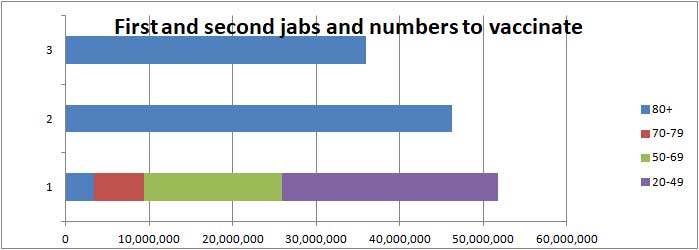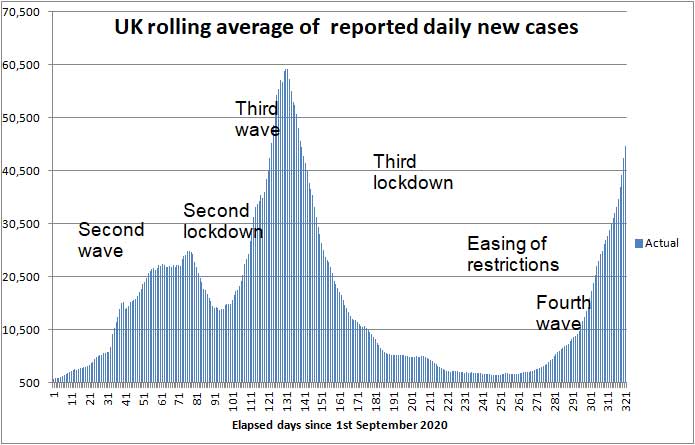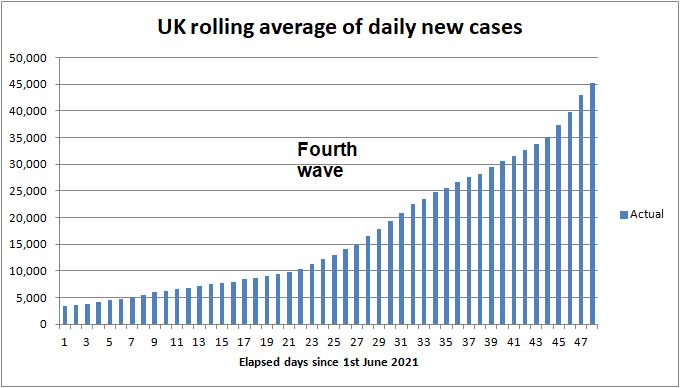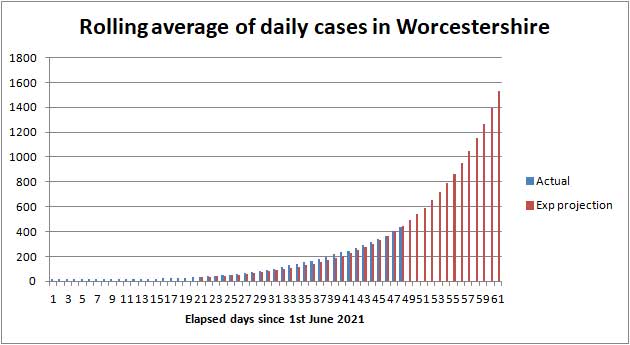
Angus and Rosemary's Miscellany
of Malvern - Other Resources
|
Coronavirus (COVID-19) epidemic weekly update for Malvern SeniorsWe have been away, so our next update will be on 1st August 18th July 2021 ENGLAND EXITING LOCKDOWN ON 19TH JULY Cases continue to rise in the Malvern Hills district Skip to menu of archived pages PreambleWe keep an eye on the published government figures and monitor the media to asses the level of risk for Seniors in the Malvern Hills district. This page is normally updated every Sunday between 1800 and 2400 hours GMT. Information about Coronavirus can be found on the NHS website: https://www.nhs.uk/coronavirus How to get vaccinatedThe most important thing people can do now is get vaccinated. Most Seniors should have been double jabbed by now, but if not get your vaccine, and encourage others to get theirs. Vaccinations can now be obtained at the Three Counties Show Ground without an appointment. Monday to Friday 8.00am to 5.00pm Saturday 8.00am to 1.30pm (AstraZeneca and Moderna vaccinations available) Use Brown Gate entrance, postcode WR13 6NW
|
| Districts of Worcs | Cases | Weekly increase | Population |
| Bromsgrove | 7,757 | +633 | 98,529 |
| Malvern Hills | 3,568 | +345 | 77,545 |
| Redditch | 7,098 | +359 | 85,317 |
| Worcester | 7,807 | +733 | 103,542 |
| Wychavon | 7,533 | +500 | 126,240 |
| Wyre Forest | 6,628 | +466 | 100,957 |
| TOTAL | 40,391 | +3,036 | 592,130 |
| COMPARE WITH | |||
| County of Hereford | 8,276 | +467 | 195,000 |
| Leicester (city of) | 42,078 | +1,260 | 400,000 |
Cumulative cases reported by PHE in Worcestershire to 18th July 2021
The weekly increase is indicative; the seven day average by area, which varies day to day, is an alternative metric that can be found on the Coronavirus dashboard.
Nevertheless you will see cases in Worcestershire are soaring and the infection rate per head of population now exceeds that in the City of Leicester.
Interactive map
At the bottom of the Coronavirus Dashboard (daily update) page there is an Interactive Map which is coloured to show the variation in infection rate across the country. The map, which is increasingly turning purple, shows that infection rates are continuing to rise in England, while encouragingly rates have fallen in some areas of Scotland.
Click for Interactive Map of COVID cases
Note: the Interactive Map works on desktop PCs but it's possible you may encounter difficulties using a tablet or smartphone.
Ripples of the fourth wave continue to spread into Worcestershire. Recent weekly cases to 13th July are: North Malvern 27; Malvern Link 15; Pickersleigh 22; Barnards Green 10; Malvern Wells and Priory 21; Callow End and Hanley 32; Upton and Welland 21.
Number of deaths
Statistics on COVID deaths are published by Public Health England, The Office of National Statistics, and NHS England.
PHE figures
Public Health England reports that the cumulative total of COVID (28) deaths in UK hospitals and care homes has risen by 283 in the last week to 128,708 while the daily average has increased from 29 to 40 deaths per day.
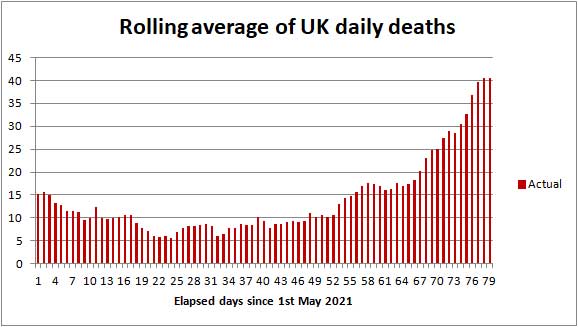
COVID-19 death rate 1st May to 18th July 2021
Click to view the UK government Coronavirus Dashboard
On average, the daily rate is increasing by one every day.
In comparison averaged over recent years 1,700 people die daily from all causes.
ONS figures
The Office of National Statistics (ONS) separately reports registered deaths in England and Wales where COVID-19 is mentioned on the death certificate. The ONS figures lag the PHE figures by 10 - 14 days and do not include Northern Ireland and Scotland.
Click for national ONS data on deaths (Excel spreadsheet)
The ONS figures are broken down by District providing a glimpse of where deaths are occurring. The provisional cumulative total of COVID related deaths in Worcestershire reported by the ONS up to 2nd July 2021 (week 26 of 2021) is shown below.
Note: the numbers are from the ONS Death Registrations-Pivot table
| Districts of Worcs | Deaths 2020 |
Deaths 2021 |
Week 26 | Population |
| Bromsgrove | 164 | 101 | 0 | 98,529 |
| Malvern Hills | 61 | 83 | 0 | 77,545 |
| Redditch | 108 | 85 | 0 | 85,317 |
| Worcester | 87 | 116 | 0 | 103,542 |
| Wychavon | 157 | 119 | 0 | 126,240 |
| Wyre Forest | 171 | 106 | 0 | 100,957 |
| TOTAL | 748 | 610 | 0 | 592,130 |
Provisional cumulative COVID-19 deaths registered by ONS to 2nd July 2021
Once again no COVID deaths were recorded in Worcestershire but expect this to change in coming weeks as new cases mount.
So far in England and Wales 109 COVID-19 related deaths have been reported by the ONS in the week to 2nd July; 11 more than last week. Of these 10 were in a care home, 11 at home, 2 in a hospice, 84 in hospital and 2 elsewhere.
Note: summation of rows 9 to 339 of the ONS deaths Registrations-Pivot table.
The provisional UK COVID-19 death toll (as reported by PHE and ONS) for all weeks of the epidemic can be found on the Deaths tab of the Coronavirus Dashboard.
NHS England figures
The table below shows latest COVID deaths in Worcestershire hospitals reported by NHS England to 16th July.
| Worcestershire | Cumulative deaths | Past week |
| Acute hospitals | 809 | 1 |
| Care hospitals | 63 | 0 |
| TOTAL | 872 | 0 |
Click for NHS COVID-19 Daily Deaths
The first death in a month was recorded this week. During the summer we anticipate the COVID death rate in Worcestershire could rise towards 30 deaths per week.
Risk of COVID-19 death by age band
NHS England provides an analysis of COVID-19 deaths in hospital in England and Wales by age band. Shown below is a breakdown of recent deaths for the period 1st June 2021 to 8th July 2021 when the death rate averaged 10 deaths per day.
| Age band | Number of deaths | % of deaths |
| 0 - 19 | 5 | 1 |
| 20 - 39 | 17 | 5 |
| 40 - 59 | 66 | 18 |
| 60 - 79 | 135 | 37 |
| 80+ | 144 | 39 |
Risk of COVID-19 death by age band
Those aged 60+ years still account for 76% of deaths compared to 92% last year, but remember the death rate as a proportion of new cases is much lower than in 2020.
Most fatalities are said to have been vulnerable people with an unhealthy lifestyle, and the obese.
Healthcare numbers
The UK government Coronavirus Dashboard includes important information about healthcare statistics.
| Hospital COVID cases (UK) | Number | Change since last week |
| Patients currently in hospital | 3,964 | +1,233 |
| Patients on ventilation | 551 | +137 |
| Patients admitted daily | 740 | +177 |
Headline summary of patients in hospital as reported 18th July 2021
The daily number of hospital admissions expressed as a 7 day average fell to 100 about 20th May but has risen to 740 and might be expected to increase further in proportion to the rise in daily cases. If roughly 2,000 new cases per day in May led to 100 daily admissions, then the current (average) 45,000 or so cases per day could see daily admissions rising towards 2,250. Alternatively using Sir David Spiegelhalter's ratio of 1 in 40, daily hospital admissions might be 1,125 per day.
In the past, the steady state number of COVID patients in hospital has been roughly ten times the number of patients admitted daily, so we could see the number of COVID patients in hospital rising to between 11,250 and 25,000 in August. This would be a significant burden on the NHS, as it had huge difficulty coping with 40,000 COVID patients earlier in the year.
Last week we assumed that due to vaccination 1 in 13 of those admitted to hospital now dies (whereas last year it was 1 in 5). If we relate the latest average of 40 deaths per day to hospital admissions two weeks ago the figure might be nearer 1 in 9, in which case the present 740 hospital admissions per day could point to a COVID daily death rate of about 80 in the first half of August, and were daily hospital admissions to reach 2,250 it's not impossible the death rate might be heading towards 250 by the end of August.
Worcestershire hospital beds
Tabulated figures for bed occupancy in Worcestershire Acute and Care hospitals can be found on the NHS England website.
Click for NHS England COVID-19 Hospital bed Activity
An easy to read summary can be found on the Worcestershire Coronavirus Dashboard.
Click to view Worcestershire Coronavirus Dashboard.
Recently there have been 13 COVID-19 patients occupying Worcestershire Acute Hospital beds, of which 3 are ventilated bed; an increase of 5 on last week.
As the fourth or EXIT wave progresses don't be surprised to see the number of COVID beds in Worcestershire rising towards 100, compared to 260 at the peak of the epidemic.
Note: it's possible as hospitals fill in Birmingham, where there are many more cases, part of the overflow could be sent to acute hospitals in Worcestershire raising numbers further.
Forecast for the week ahead
Trends suggest that during the next seven days (up to 25th July) the cumulative total of new UK COVID-19 cases reported by PHE on the Coronavirus Dashboard could increase by 350,000 towards 5,785,000.
In Worcestershire 4,500 new cases of COVID-19 can be expected, and up to 500 cases in the Malvern Hills district.
We estimate the number of COVID (28) deaths will increase by about 315 nationally towards 129,025 during the 7 days ending 25th July 2021.
In the county of Worcestershire, assuming a 0.3% death rate, the 3,036 new cases this week should translate to no more than 9 COVID deaths per week in early August.
Longer term forecast
When the Alpha (Kent) variant was predominant commentators suggested that the UK could be approaching herd immunity due to both the success of the vaccination programme, and immunity of those who had already been infected by COVID-19. The flare up of cases across the UK caused by the more transmissible Delta variant suggested a higher level of vaccination such as 85% might be needed to counter the Delta Reproduction Rate estimated 6 to 7. However this assumes that vaccinated individuals do not catch COVID and pass it on to others.
In fact, vaccinated individuals are catching COVID, but there seem to be no established figure for the reduction in transmission. If it is assumed transmission is reduced by a factor of ten then vaccination of 94% of the population would be needed to achieve herd immunity. If the reduction is slightly less than ten approaching 99% have to be vaccinated, whilst if the reduction is not enough to cancel out the Reproduction Rate of the virus then herd immunity becomes impossible to achieve.
Currently only 55% of the population has been fully vaccinated, so after the 19th July when legal restrictions are lifted we must continue to rely on social distancing and wearing face coverings in crowded enclosed settings, else risk the virus spreading exponentially and overwhelming the NHS.
The next chart shows the rolling average of daily cases in red and an illustration of possible future cases assuming these follow the present trajectory.
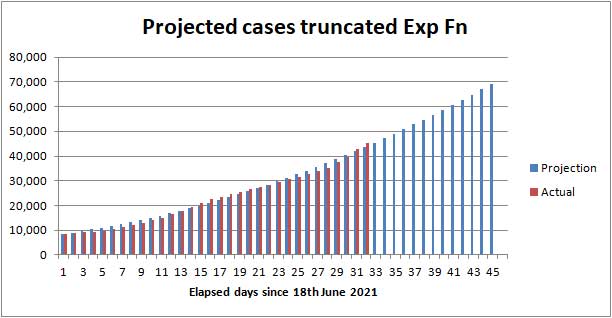
Illustration of possible future UK daily cases to 31st July 2021
The blue curve is a truncated exponential function approximating to the wobbly rise in cases since the 18th June. This suggests daily cases might rise to 70,000 by the end of July if behaviour remains as it is.
After the government lifts restrictions on 19th July we can expect fewer COVID cases in children due to the end of the summer term, offset by more mingling of adults in social and business settings, and families visiting tourist destinations. More and more pockets of infection are likely to flare up as the virus moves across the four nations of the UK seeking out the vulnerable and unvaccinated resulting in high levels of infection throughout the summer.
A sensitivity analysis of SPI-M modelling results indicates that it is impossible to forecast with any accuracy whether the NHS will be overwhelmed by COVID patients in August. So the government says the figures will be watched very carefully and measures would be taken should there be any danger of strain on the NHS.
Scientists also say it is impossible to predict when the EXIT wave will peak and that will probably not be known for sure until two or three weeks after the peak is past.
Sajid Javid has already warned that 'bed blocking' by COVID patients is likely to seriously extend hospital waiting lists.
So far the COVID death rate during the 'fourth or EXIT wave' has remained low and our hope is that it won't rise much above 100 before falling back in the autumn, as the percentage of the population vaccinated rises, and survivors develop immunity, although models suggest rates of up to 300 deaths per day cannot be ruled out.
Little is being done to protect those aged under 18 years and a ripple of cases amongst unvaccinated children and teenagers can be expected when pupils return to school in September.
We'll just have to wait and see how things pan out in coming weeks and adjust our behaviour accordingly.
Advice for Seniors
 Due
to vaccination the death rate this summer is broadly a factor of 15 times
lower than last year. However the daily number of new cases of
Coronavirus in the Malvern Hills district has been rising sharply, and 76% of deaths are still amongst those aged 60+ years, despite
most Seniors having had 2 jabs. We therefore judge the
risk of death from COVID-19 for
fully vaccinated Seniors to be
in the range
LOW for the healthy towards MODERATE
for the frail and vulnerable;
see our annex and riskometer opposite.
Due
to vaccination the death rate this summer is broadly a factor of 15 times
lower than last year. However the daily number of new cases of
Coronavirus in the Malvern Hills district has been rising sharply, and 76% of deaths are still amongst those aged 60+ years, despite
most Seniors having had 2 jabs. We therefore judge the
risk of death from COVID-19 for
fully vaccinated Seniors to be
in the range
LOW for the healthy towards MODERATE
for the frail and vulnerable;
see our annex and riskometer opposite.
Remember, if you are elderly, have not been vaccinated, and were to catch COVID there is a significant chance that you will either die or your long term health may be seriously damaged, so if you are able get both doses of your vaccine and continue to take care of yourself and those you love. Also encourage others to be vaccinated.
Click for our risk of death table (for those who have not been vaccinated)
Like Sajid Javid, it is quite possible, despite a second jab, for Seniors to become ill with COVID-19; some might have mild symptoms like a common cold or hay fever, while others could feel very poorly, but few except the frail and vulnerable will need to be admitted to hospital.
Until this summer's crisis is over the simple safeguards to remember are to:
-
wash your HANDS thoroughly, using soap and hot water, for 20 seconds, including after handling deliveries to your home, to kill virus picked up from contaminated surfaces see note 1;
-
wear a FACE covering when unavoidably near other people for example when shopping, visiting hospital or the chemist, and using public transport;
-
SPACE at least 2 metres from people you don't feel safe with see note 2;
-
preferably socialise with friends and other households outdoors in the FRESH AIR, else, if you can, keep doors and windows open if you are indoors;
-
minimise TIME near strangers;
-
look out for symptoms and self-isolate and book a test if you feel unwell (the top five symptoms amongst the vaccinated in order of prevalence are now said to be headache, runny nose, sneezing, sore throat and loss of smell).
-
keep away from crowded indoor settings and areas where the infection rate is known to be high.
-
Respect others and give them space.
Notes:
1) Wash your hands thoroughly before touching your face to avoid transferring virus from contaminated surfaces to your mouth, eyes and nose. If outdoors use hand gel.
2) Two metres is further than you think - roughly an arm and a walking stick away.
Annex to 18th July update
Commentary
On Monday the PM held a press briefing confirming England would move to STEP 4, the lifting of most legal restrictions, on 19th July 2021. He struck a more cautious tone than the previous week emphasising that we must continue to be cautious to avoid hospitals being overwhelmed with COVID patients in August.
Click for PM statement at coronavirus press conference: 12 July 2021
He emphasised face coverings should continue to be worn in crowded settings such as public transport.
Contrary to last week the PM urged nightclubs and other venues with large crowds to make use of the NHS Covid Pass - which shows proof of either vaccination, a recent negative test or natural immunity – as a means of entry.
Guidance would be updated for the Clinically Extremely Vulnerable on how they can keep themselves safe.
We imagine the extremely vulnerable are going to have to self-isolate once again.
Also on Monday, SPI-M Modelling results dated 7th July were published setting out what might happen after the lifting of restrictions on 19th July.
Click for summary of further modelling of easing restrictions
SPI-M say that all the models show a period of extremely high prevalence of infection lasting until at least the end of August - there is high uncertainty about the scale of the peak in prevalence - and the scale of the next wave in hospital admissions is also highly uncertain.
Our interpretation of the modelling is that new daily cases might peak at between 60,000 and 100,000 sometime between mid August and mid September; daily hospital admissions could peak at somewhere in the range 800 to 5,000 in September; COVID hospital bed occupancy could reach 20,000; and the daily death rate could peak somewhere between 200 and 600.
The projections mostly follow a bell shaped curve with the fourth or EXIT wave of the epidemic tailing off by Christmas 2021.
On Tuesday South Shields was mentioned as having the highest infection rate in England.
On Wednesday the Mayor of London said a bye law would be introduced requiring the wearing of face coverings on public transport, which would not be law but a condition of carriage.
Majorca, Menorca, Ibiza and the British Virgin Islands were moved to the Amber travel list.
Click for Red, amber and green list rules for entering England
On Friday we heard Worcestershire grab-a-jab vaccination clinics would be open during July as follows:
If you are 18 or over you can grab a Jab at the following sites. No need to book, simply turn up to get your vaccination.
-
Artrix, Bromsgrove, B60 1GN: Monday to Saturday 8.00am to 7.30pm and Sunday 8.00am to 1.30pm. (AstraZeneca and Pfizer vaccinations available).
-
Three Counties Showground, Malvern, WR13 6NW: Monday to Friday 8.00am to 5.00pm or Saturday 8.00am to 1.30pm (AstraZeneca and Moderna vaccinations available).
-
St Peter’s Baptist Church, Worcester, WR5 3TZ: Monday to Saturday 8.00am to 7.00pm (AstraZeneca and Moderna vaccinations available).
On Friday evening the government announced that travellers entering England from France, which is on the Amber list, would have to quarantine after 19th July irrespective of vaccination status. This was said to be due to the South African or Beta variant circulating in France, which makes one wonder what protection the Astrazeneca vaccine provides against Beta?
On Saturday the media reported the Chief Medical Officer and ex Health Secretary Jeremy Hunt as saying England could be forced back into lockdown within 5 weeks.
Health Secretary Sajid Javid said he had tested COVID positive despite being fully vaccinated.
Denmark put the UK except Wales on their red list.
There are rumours that a shortage of lorry drivers together with people being pinged to self isolate is resulting in delayed deliveries to some supermarkets.
Other weekly updates
Click to watch Tim Spector's weekly Zoe COVID update on YouTube
According to the Zoe COVID study the most common symptoms of COVID are now.
| Vaccinated | Unvaccinated |
| Headache | Headache |
| Runny nose | Sore throat |
| Sneezing | Runny nose |
| Sore throat | Fever |
| Loss of smell | Persistent Cough |
Unvaccinated and vaccinated individuals are being infected in roughly equal numbers.
Cases are rising steeply in the NE but going down in London.
We probably have yet to see the after-effect of the Euro football matches and the lifting of restrictions.
In Europe cases in Spain and the Netherlands are rising steeply like those in the UK while Portugal and Greece are not far behind.
The first 25 minutes of the weekly Independent SAGE briefing is worth looking at if you are interested in charts and how the numbers are changing:-
Click to watch Independent SAGE 16th July briefing
Overseas travel
Confusion over travel arrangements has returned. Travellers from the UK are unlikely to be welcome abroad as infection rates in England and Scotland are very high.
It is now possible to get an NHS Vaccination Pass for overseas travel, which will require you to prove your identity for example by providing a photo of your passport; this should facilitate return to the UK from Amber list countries, except France.
Click for information about the NHS COVID Pass
See BBC report - EU vaccine 'passport' and what it means for travel
List of vaccines (unchanged)
Here is the list of vaccines ordered by the UK - a shortage of vaccine had been limiting the vaccination rate in the UK earlier in the year, but possibly not now. Plenty of vaccine is on order for delivery later in 2021 some of which may be needed for booster jabs and vaccinating those aged 12 - 18 years.
| COVID-19 vaccine | Doses ordered (million) | Status |
| Pfizer BioNTech, two dose, -70 deg C | 40+60 | Approved, deliveries continuing, made in Belgium (EU). An additional 60M doses have been ordered for booster shots for the most vulnerable in the autumn. |
| Astrazeneca, two dose, fridge | 100 | Approved for those aged 30+ years; deliveries continuing. Batches made in UK, Belgium and India. |
| Moderna, two dose, -20 deg C | 7+10 | Approved. First deliveries to Wales and Scotland 7th April 2021 then England 13th April; mainly for those aged under 50 years awaiting vaccination. |
| Valneva, two dose | 60+40 | A jab from French company Valneva will be made in Livingston, West Lothian, Scotland. Delivery to start in second half of 2021. |
| Janssen, single dose | 20 | Approved, a jab from Belgian firm Janssen, owned by Johnson and Johnson; UK approval 28th May. Order reduced from 30 to 20M. |
| Novavax | 60 | A jab manufactured by US firm Novavax is being made in Stockton-on-Tees UK; phase III trials complete, awaiting approval. Should be available later this year. Glaxo Smith Kline (GSK) has been contracted to fill and package vials. |
| GSK Sanoft | 60 | Some delay due to adjusting the formula to give better protection to the elderly; possible availability late 2021. |
| Curevac | 50 | Contract placed with German company Feb 2021. Possible source of new variant vaccine later in 2021 |
Table of vaccines ordered by the UK government
Present rate of new cases and risk
The hotspots in England and Scotland are expanding across the whole of the UK and the general infection rate is now very high; were it not for the vaccines the death rate would be heading towards 1,000 deaths per day.
The average rate of infection per 100,000 population per week in England has risen from 301 to 399 while in comparison the figure for Worcestershire has risen to 393 and the Malvern Hills to 291.
As a yardstick we suggest a figure of below 10 can be considered LOW.
There is now a fair chance of catching COVID-19 within the Malvern Hills, but as most Seniors have been vaccinated with 2 jabs we judge the risk of death LOW for the healthy, and MODERATE for the frail and vulnerable.
The risk of death from Coronavirus for unvaccinated children and healthy teenagers is said to be small so for them the risk is LOW. There is however emerging concern that one in six youngsters might suffer from Long COVID.
The middle aged can suffer from debilitating Long COVID so for those that have not been vaccinated the risk might be judged HIGH.
COVID-19 can seriously damage the organs of the very ill admitted to hospital.
About the final UK COVID-19 death toll (unchanged)
At the start of the epidemic on 17th March 2020 the Chief Scientific Adviser, Sir Patrick Valance, questioned by the Health Select Committee, did not disagree with Jeremy Hunt's suggestion that a death toll of 20,000 might be a reasonable outcome.
On the other hand, Professor Neil Ferguson of Imperial College warned in some scenarios the death toll might be as high as 250,000; while we thought, in the very worst case assuming up to 1% of the UK population died the outcome might have been nearer 400,000 taking into account some build up of herd immunity.
So how well will the UK have done? When Jeremy Hunt and Sir Patrick Valance spoke there had been few deaths and they clearly underestimated what was to come. Professor Neil Ferguson was nearer the mark. A few might consider an outcome of about 129,000 deaths a fair result compared to a greater number of people dying in a very short space of time, more being permanently disabled by Long COVID, temporary collapse of the NHS and patients dying at home or queued in ambulances outside hospitals. You have only to look at the recent situation in India to imagine what could have happened.
Members of the Labour Party and others will no doubt say the UK has done poorly compared to the best performing countries such as Australia, New Zealand and Singapore where deaths have been much lower, not to mention the enormous expense of supporting those out of work and huge damage to the economy.
With hindsight, deaths might have been much lower if the second lockdown had been continued into December and January, but that would have meant cancelling Christmas, and who knows to what extent the public would have complied.
Worldwide, this pandemic is not played out and it could be a further 1 to 2 years before the 'dust' finally settles. The PM has promised an independent inquiry in Spring 2022 to learn lessons for the future.
Summary of Links
Symptoms
Article about the effects of Coronavirus on the human body
Reporting and how to obtain a test
How to get a test
https://www.nhs.uk/coronavirus
About joining the Zoe COVID Symptom Study:
Guidance
UK government Coronavirus guidance
Tiers
Guidance on tiers: what you need to know
Government postcode checker to find tier for other areas
Statistics
UK government Coronavirus Dashboard
Coronavirus Dashboard Interactive Map
ONS data on deaths in England and Wales (Excel spreadsheet)
NHS England COVID-19 Daily Deaths
NHS England COVID-19 Hospital Admissions
NHS England vaccination statistics
Worcestershire Coronavirus Dashboard
Worcestershire COVID-19 Vaccinations Dashboard
A glimpse of the worldwide vaccination situation can be found on the Our World in Data website.
Click for chart showing % vaccinated
Modelling
A projection of the future COVID-19 death toll and daily deaths can be found on The Institute for Health Metrics and Evaluation website.
Click for IHME projection of COVID-19 deaths
Reports
ONS Coronavirus (COVID-19) Roundup
The bigger picture
Worldometer summary of coronavirus cases worldwide
European Centre for Disease Prevention and Control info
https://www.ecdc.europa.eu/en/geographical-distribution-2019-ncov-cases
World Health Organisation info
Window on the USA
Centre for Disease Control (CDC)
American Association of Retired People (AARP)
Worcestershire
Help:
http://www.worcestershire.gov.uk/here2help
Worcestershire County Council COVID-19 information:
http://www.worcestershire.gov.uk/coronavirus
Here you will find a useful link,
'Website: Number of new cases by date in Worcestershire'
which displays interesting COVID charts and statistics for Worcestershire
Miscellaneous
Spanish Flu
Dr Jeff Kildea's commentary about the 1919 outbreak of Spanish Flu in Australia
Views of Martin McKee, Professor of European Public Health
Follow Martin McKee on Twitter
SAGE membership
Scientific Advisory Group for Emergencies (SAGE)
Scottish government:
Link to Scottish Government website
Link to Postcode checker for COVID restrictions by protection level in areas of Scotland
Welsh Government:
Guidance on COVID alert levels in Wales

The interpretations and opinions expressed are our own
Last updated 26th July 2021
 Blogs
>
Blogs
>
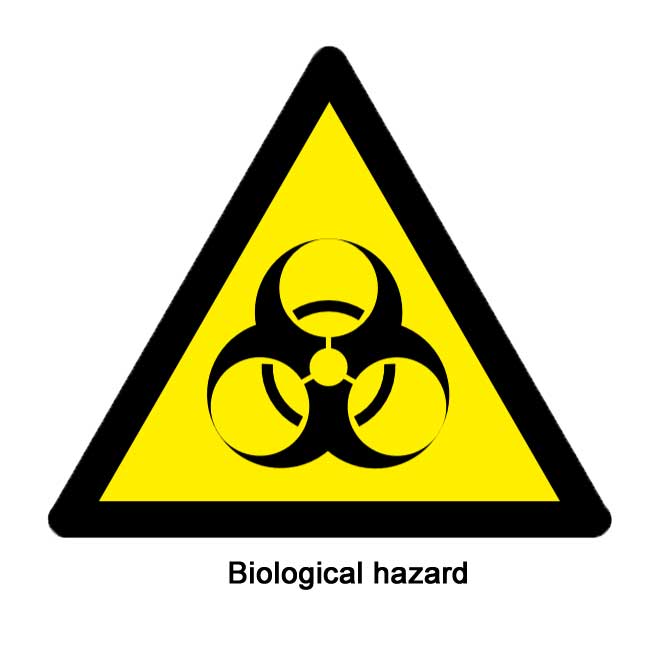 How
to request a COVID test
How
to request a COVID test You
can help others by downloading the COVID Symptom Study app onto your
smart phone or Ipad and reporting how you feel either daily, or as you are
able. Note there is no desktop PC version for Windows.
You
can help others by downloading the COVID Symptom Study app onto your
smart phone or Ipad and reporting how you feel either daily, or as you are
able. Note there is no desktop PC version for Windows.